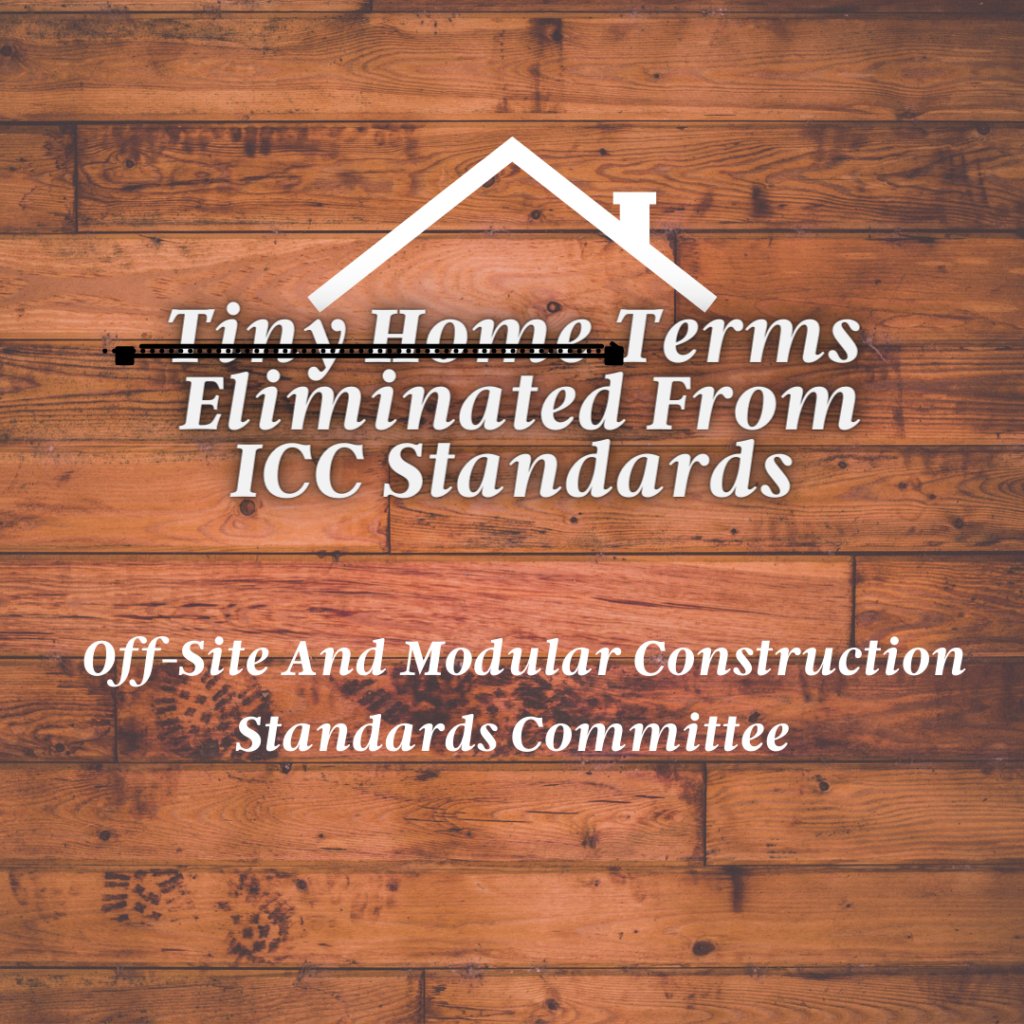ICC Off-Site And Modular Construction Standards Committee
The Off-Site and Modular Construction Committee (IS-OSMC) held its first in-person, public meeting on Nov. 19–20, 2019, in the Chicago, Ill., area to begin the development of two new standards to address the challenges currently faced by the industry and to offer a path for compliance on the regulatory side. The meeting organized workgroups and developed initial drafts of the standards for eventual posting for initial public input. The committee is made up of representatives from several different interest categories to develop consensus documents for eventual submittal to the American National Standards Institute as American National Standards.
Originally tiny homes were excluded.
Second IS- OSMC Meeting January 16th, 2020
At the second meeting, tiny homes were then included.

Development Of Two New Standards
The Off-Site and Modular Construction Committee (IS-OSMC) held its third in-person, public meeting on March 11–12, 2020, at the World of Modular Conference in Orlando, Fla., to continue development of two new standards to address the challenges currently faced by the industry and to offer a path for compliance on the regulatory side.
Building Safety Journal
ICC 1200 —Standard for Off-Site Construction: Planning, Design, Fabrication and Assembly
The new ICC 1200 — Standard for Off-Site Construction: Planning, Design, Fabrication and Assembly (IS-OSMC) would address all facets of the off-site construction process, including planning, designing, fabricating, transporting, and assembling commercial and residential building elements. The standard includes componentized, panelized and modularized elements and will not apply to the United States Department of Housing and Urban Development manufactured housing or “tiny homes.”
Helpful Definitions Of Terms In The Standards
Off-Site Construction
A modular building, modular component or panelized system which is
designed and constructed in compliance with this standard and is wholly or in substantial part fabricated
or assembled in manufacturing plants for installation – or assembly and installation – on a separate
building site and has been manufactured in such a manner that all parts or processes cannot be
inspected at the installation site without disassembly, damage to, or destruction thereof.
Modular-Industrialized Housing And Buildings
Industrialized Housing
Modular Component
A residential structure that is designed for the occupancy of one or more
families, is constructed in one or more modules, or constructed using one or more modular
components, built at a location other that the permanent site and is designed to be used as a
permanent residential structure when the module or modular component is transported to the
permanent site and erected or installed on a permanent foundation system.
A sub–assembly, subsystem, or combination of elements, including panelized
systems, building shells or bathroom pods, for use as a part of a modular building that is not structurally
independent, but is a part of structural, plumbing, mechanical, electrical, fire protection, or other systems affecting life safety.
Module
A three–dimensional, volumetric section of a modular building designed and approved to be
transported as a single section independent of other sections, to a site for on–site construction.
Tiny Homes Were First Excluded, Then Included And Now All Tiny Home Terms Were Deleted
After The ICC Code Action Hearing ( CAH)
Tiny homes were first excluded, then included, and because the proposal was voted down by the code council, all terminology of tiny homes has been stricken.
Reason: This Committee proposal deletes all mention of tiny homes in the ICC 1200 & 1205
Standards. Requirements for tiny homes are adopted by the AHJ, and should not be mandated by the Standards. AHJ may adopt IRC Appendix Q, but they may not. This will leave that decision up to them and not require it when the Standards are adopted.
Explaination From The Co-chair
We originally did not include tiny homes in the standard. When we got input from the tiny home industry and a representative on the working group for the standards, we added tiny homes in with a definition and various new sections for items specific to tiny homes.
During the ICC Code Action Hearing (CAH), I was the proponent of the proposal to reference ICC 1200 and 1205 into the 2024 IBC as a means to review and approve offsite construction components. It was clear to me from the committee’s questions:
They really didn’t have a good understanding of offsite construction generally speaking, and not a good understanding that we were ONLY trying to address the approval process not change the codes themselves.
They had a LOT of questions specific to tiny homes that I could not answer as I’m not knowledgeable on the subject nor did I feel it was my place to speak on behalf of tiny homes. Do they have to comply with Appendix Q? Can a window be a means of egress? No one from the tiny home industry participated in the hearings so those questions went unanswered, hurting our overall chances.
They did not like that, if adopted, ALL states would have to follow this standard, including the states that already have an administrative program.
They shot down our proposal 13-1.
In regrouping with the committee, we agreed to not spell out any specific types of offsite components such as tiny homes. But they are not excluded either. We also added a provision that the states use this standard OR their own administrative program. That gives states the flexibility to say what is and is not included in their programs. We did not spell out other types of products for inclusion, leaving it up to the AHJ to include or not. We feel that we now have a better chance to get these standards referenced in the codes, but first have to overcome the CAH recommendation to disapprove and get 2/3rds vote to do so. Then get the same committee to approve our revised proposal.
At this point in the process, the standards were sent out to the committee for a final vote without tiny home language. I voted affirmative. Not sure what the next steps are in the ANSI process before its final. I also plan to submit a public comment in an effort to overcome the CAH recommendation. But that does not mean that tiny homes are excluded, they just are not specifically called out.
GLO2-21 Disapproved For IBC Inclusion
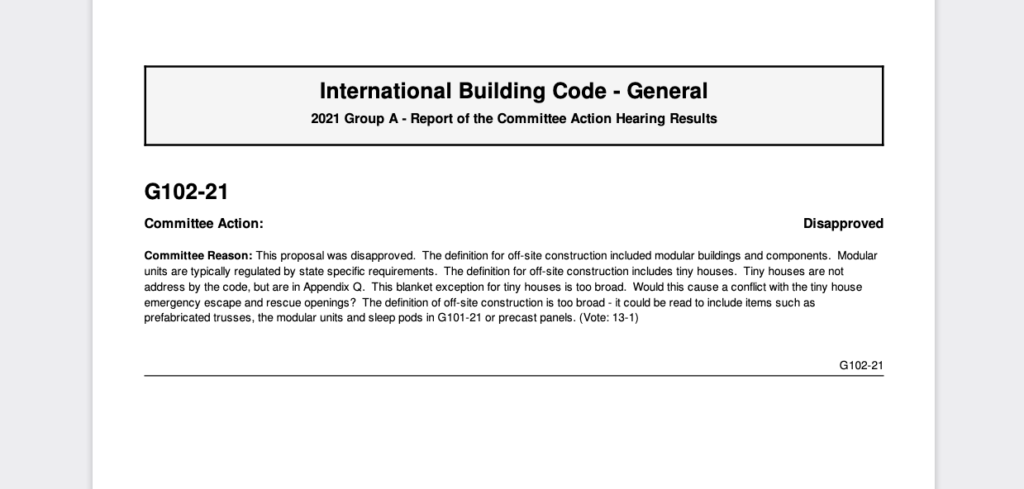
Tiny Homes On Wheels Are RVs
I was told my the chair that the code council, which is made of of building code officials, still sees tiny houses on wheels as an RV and that we should not use the terms tiny homes are tiny houses.
OFF-SITE AND MODULAR CONSTRUCTION COMMITTEE (IS-OSM
Committee Approved 516/21
Discussion of code change proposal G102–21:
Prior to the meeting Mr. Aittaniemi had forwarded a link of the video of the testimony associated
with the code change proposal G102–21 to all the committee members. Based on the code
committee’s disapproval, several ideas were discussed on how to move forward:
a. Editing the standard verbiage to address the code committee’s concerns, namely,
– Where adopted, Tiny Homes shall comply with App Q, IRC
– Eliminating tiny home terminology within the text
May 21st, 2021 Car Report
The committee deletes all mention of tiny homes.
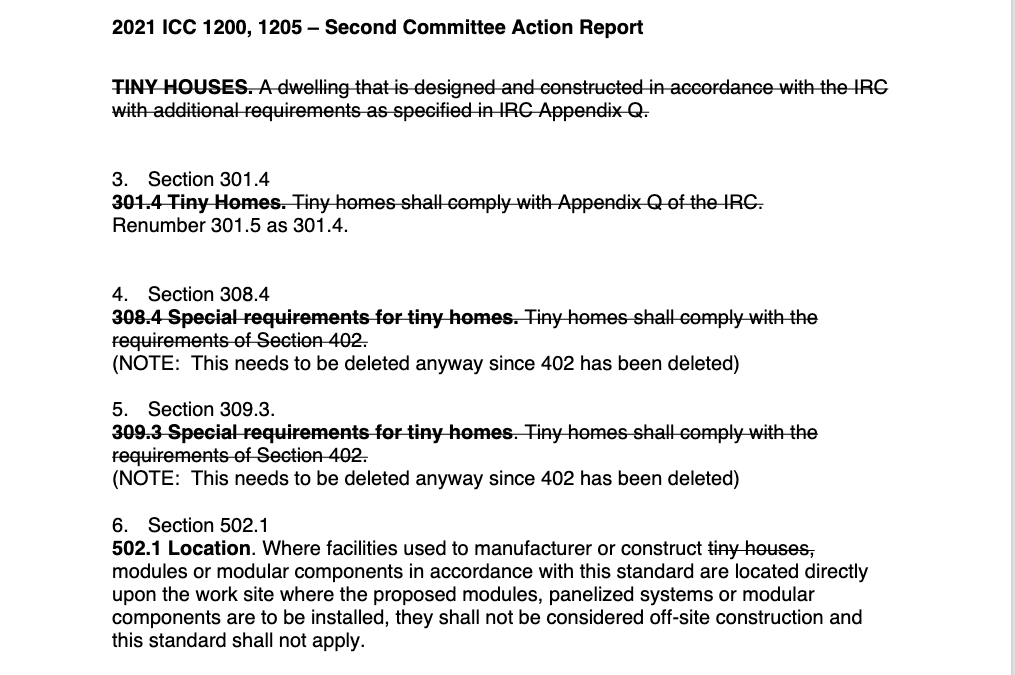
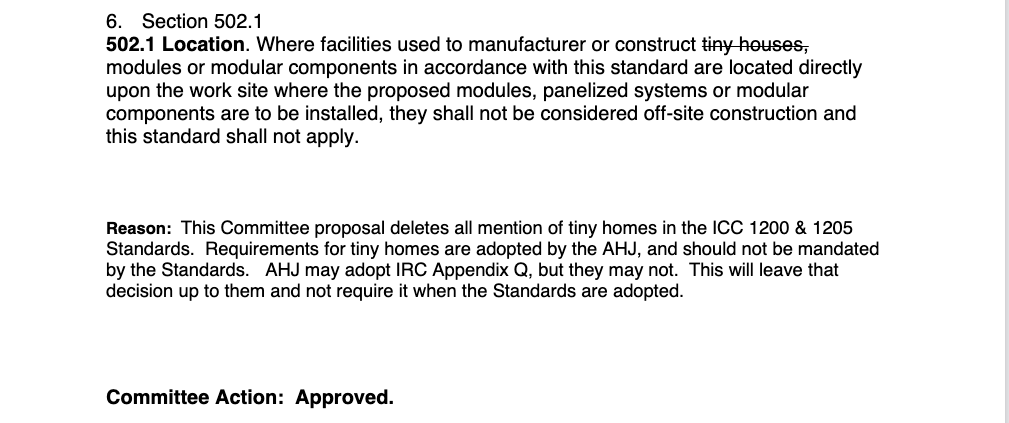
Both ICC 1200 and ICC 1205 received ANSI Approval
as American National Standards on July 19, 2021.
To view the committee approved drafts, please see posted documents under “Administration” below.
Administration
ICC 1205 draft ballot approved:
Standard for Off–Site Construction: Inspection and
Regulatory Compliance
7/01/2021: Link
ICC 1200 draft ballot approved:
Standard for Off–Site Construction: Planning, Design,
Fabrication and Assembly
7/01/2021: Link
What Is The Outcome For Tiny Houses Regarding
Being Excluded, Included And Finally Deleted?
I do not think the outcome is necessarily negative because Appendix Q Tiny House addresses tiny houses on a foundation, 400 square feet or less which has been adopted by over half of the country.
A tiny modular house can be built to comply with all applicable state and local building codes required by the location where the house will be placed.
It Is Time To Develop Standards Specific To Tiny Houses
The outcome for tiny homes in the ICC Off-Site And Modular Construction Standards Committee does reinforce the need for the tiny house industry to develop standards specific for tiny houses, especially for tiny houses on wheels. Code officials may still see tiny houses as RVs, but it is the Mayors, City Council Members, County Commissioners that are desperate to find solutions for affordable and attainable housing and are opening doors for the allowance of tiny houses as a viable option for housing.
I read today that in America, there is a shortage of 7.2 million affordable housing units for extremely poor families; 75% of those who find housing pay over half of their income for shelter. Over 500,000 people are now homeless. Even though housing is the most cost-effective strategy to reducing generational poverty, there is no state or county where a working full time at minimum wage can afford a two-bedroom apartment, according to the National Low Income Housing Coalition.
National Low Income Housing Coalition .
Article Source Waco Tribune
Jimmy Dorrell: Waco’s Gentrification Forcing It’s Poor Into The Streets
Adoptable Appendices In The International Residential Code
For Cob Construction And Tiny Houses
IRC Appendix AQ Tiny Houses
The 2018 IRC included an adoptable appendix for tiny houses. The provisions for tiny houses were based on code change RB168–16 from the 2016 Group B cycle of code development. They have been subsequently revised in the 2021 IRC by code change RB292–19 in the 2019 Group B cycle of code development.
The following are excerpts from the reason statement and the code itself, which provide an overview of the appendix provisions:
Similar to the format for the body of the code, this appendix is structured as follows:
Similar to the format for the body of the code, this appendix is structured as follows:
- AQ101: General (Scope)
- AQ102: Definitions
- AQ103–AQ106 Technical provisions
- AQ103: Ceiling Height
- AQ104: Lofts
- AQ105: Emergency Escape and Rescue Openings
- AQ106: Energy Conservation
- There are no standards referenced in the provisions
- There are no standards referenced in the provisions
Tiny houses are typically constructed in a factory setting — often called “off-site” or “modular” construction — and transported to the site and placed on a permanent foundation. While the code provisions of Appendix AQ, if adopted, govern code compliance, since the unit is built off-site, challenges can arise in terms of assessing the manufacture of the unit and how to inspect for code compliance. The International Code Council recently completed two ICC standards for off-site construction to address these challenges and offer a path for compliance, namely: ICC/MBI Standard 1200–2021 for Off-Site Construction: Planning, Design, Fabrication and Assembly; and ICC/MBI Standard 1205–2021 for Off-Site Construction: Inspection and Regulatory Compliance.
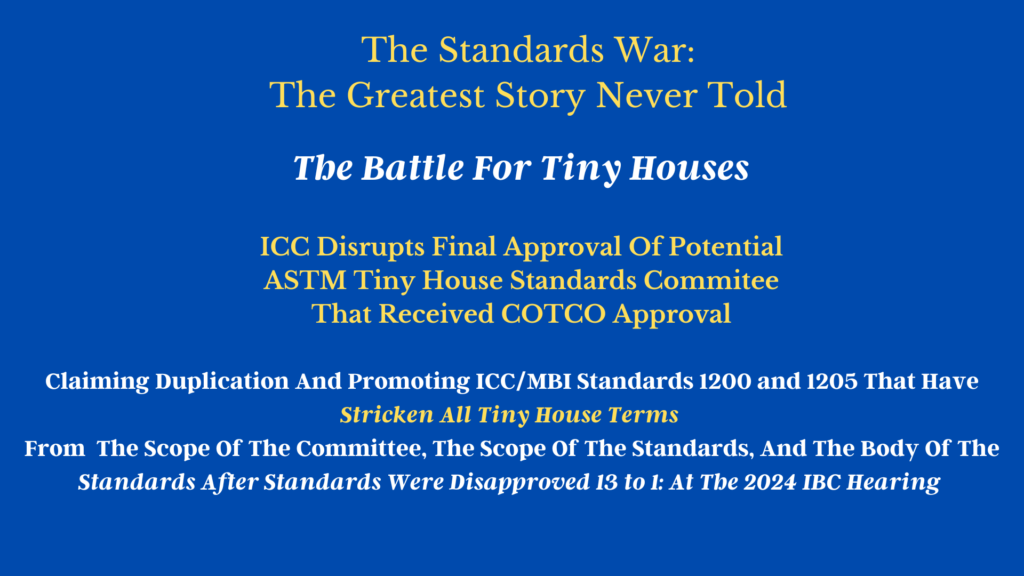
The Battle For Tiny Houses
There has been a secret standards war raging in the undercurrents of the tiny house industry that I will not be silent about anymore. For almost two years I have written with diplomacy and tried to take the high road no matter what was going on. There is too much at stake to be silent now. We have been fought by both corporate and special interest groups.
This is going to be a long read-so I will try and summarize the points ahead of time as much as I can, and you can decide if you want to dig deeper and read the entire article.
A tiny house on wheels do not have its own standard. Most often they are built to RV standards, then RVIA must lobby against the industry if tiny houses on wheels are associated with housing. Learn more.
We have been working with ASTM International for over a year and a half with the goal of being granted a committee to develop and maintain standards specific to tiny houses. We received unanimous approval from COTCO, the ASTM board that grants new technical committees. Learn More.
At the same time, we received COTCO approval, we also received the news that the International Code Council (ICC) had sent an objection letter to ASTM regarding the committee. We have been stalled now for almost 5 months. During this time, ICC has written Model Legislation for tiny houses. Learn More.
I will also address the ICC off-site and modular construction standards committee that developed two standards for modular construction, ICC/MBI 1200 ad 1205. Tiny houses were first excluded, then included, and then all tiny house terms were deleted after the disapproval at the 2024 IBC hearing. ICC has stated that tiny houses do not have to be called out because they are ”inclusive.” Learn more.
We have two states, Colorado and New Hampshire, that endorsed the ASTM tiny house committee, and were poised to reference the standards before they were even written, but we have had a cloud of opposition over this initiative that has not allowed us to progress to the real work that needs to be done.
If you are a manufacturer, or even an end user, it is important that you read this post. There are those trying to steer the industry on a path that serves their agendas, not toward a path that benefits the industry as a whole. This will greatly increase the cost of tiny houses.
ICC is trying to broadly sweep tiny houses under either Modular construction or the Manufactured Home HUD code.
We are desiring to introduce a third option, a uniform construction standard for tiny houses on wheels that will result in a new classification for tiny houses on wheels, not an RV, not a modular, not a Manufactured Home. The entire tiny house industry is invited to participate in the ASTM tiny house initiative. Learn more.
We need to cultivate and celebrate all legal paths for tiny houses and work as a united industry.
Where Is The Tiny House Industry Headed?
If you have a vested interest in the industry, and you want to not only know where the industry is going but also influence the direction, read on.
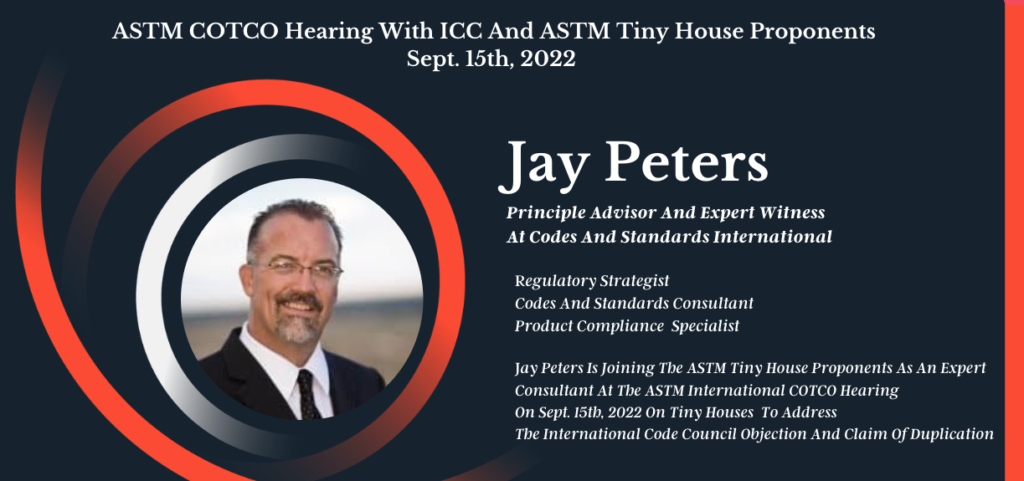
Jay Peters Consultant For ASTM Tiny House Proponents
ASTM COTCO Hearing Sept 15th, 2022 Addressing The ICC Objection
The future of the tiny house industry just got a lot brighter and we are very excited to announce that Jay Peters, the principal advisor and expert witness at Codes And Standards International is joining the ASTM Tiny House Proponents as an expert consultant at the ASTM COTCO hearing on Sept. 15th, 2022. Jay will contribute his 40-plus years of experience in the development of codes and standards and as an expert at hearings and appeals.
The hearing will be a closed session with the board of COTCO, the International Code Council ( ICC), and proponents in favor of the potential tiny house committee. COTCO is the governing board of ASTM International that grants new technical committees.
After more than a year of negotiation with stakeholders of the tiny house industry following the ANSI Essential Requirements for due process, COTCO granted a new committee for tiny houses to develop and maintain standards specific to tiny houses. The committee will go on indefinitely.
The COTCO hearing will give both the ICC and the ASTM Tiny House Proponents the floor in front of the entire board of COTCO to discuss the ICC objection and a rebuttal to the objection. The hearing will determine if the ICC objection bears any weight on the COTCO approval of the new ASTM Tiny House Technical Committee.

Related: ICC Objects To ASTM Tiny Houses On Wheels Standard
Receiving COTCO approval was a milestone that we worked hard for that entailed gathering stakeholders from the tiny house industry that negotiated with ASTM for over a year, but our joy was short lived because we received an objection to the new committee from the International Code Council ( ICC ) on the same day. The objection was quite a surprise because we had been in very close contact with ICC to make sure they knew about our potential new standards, our intentions, and how we could collaborate.
Learn More: ICC Objects To ASTM Tiny Houses On Wheels Standard


